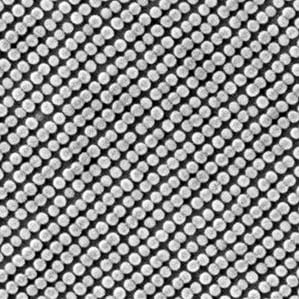A Nanofabrication Technique Doubles Hard Drive Capacity
Researchers at HGST, a major manufacturer of hard disk drives, have shown that an emerging fabrication technology called nano-imprinting could be used to double the data storage capacity of today’s hard disks. They say the patent-pending work, done in collaboration with a company called Molecular Imprints, could lead to a cost-effective manufacturing process by the end of the decade.
Hard disk drives store data in magnetic material on the surface of a spinning disk. During production, this material is deposited as a thin film. Information is then written to the disk by changing the magnetic orientation of distinct individual units of the material, known as “grains.” A group of grains together make up a region that can store a single bit. Since the 1950s, when the technology was invented, hard disk manufacturers have continually found ways to keep increasing data storage capacity by reducing the area required to store a bit, most recently by using fewer and fewer clustered grains for each.

Now the industry is running up against limits to this strategy, partly because the particles’ magnetism becomes less stable when they are very small, a phenomenon known as superparamagnetism. “If I take a permanent magnet and I make it small enough, it becomes nonmagnetic,” explains Currie Munce, vice president of HGST Research.
There are also physical limits how small the recording regions can be. “If you continue to try to push these magnetized areas closer and closer together, they finally reach a point where they can feel their neighbors to such an extent that they have a tendency to flip over,” explains Grant Willson, a materials science professor at the University of Texas at Austin. That causes data loss. Willson is a cofounder of Molecular Imprints, although he was not involved in this research.
Researchers have known for years that patterning a disk with physically isolated, nanoscopic magnetic dots makes it possible to pack in more information than applying the material as a continuous film. The challenge has been developing an economical way to manufacture disks with the precise nanoscopic patterns in the circular tracks needed for the recording head to do its work.
The HGST researchers announced at last month’s SPIE advanced lithography meeting that they had used their proprietary nano-imprinting process to pattern a disk substrate with 10-nanometer-wide dots, closely packed and in circular tracks. They showed that a recording head can read and write information from these dots, and they reported that their process could print 1.2 trillion “magnetic islands” per square inch—enough to store about a terabyte on a 2.5-inch disk, which is double the capacity of today’s devices. (The most spacious drive currently sold by HGST can store four terabytes of data.) Since the dots can be made even smaller, the method would in theory allow for several more generations of capacity gains.
Nano-imprinting, a technique that first emerged in the mid-1990s, consists of applying a soft material to a surface and then stamping it with a hard material covered with specific patterns. The resulting imprints then guide modification to the surface, such as etching or deposition of additional material. The soft material is then removed, leaving only the new designs on the original surface. The magnetic recording and semiconductor industries both view the technique as a promising solution to the puzzle of how to reliably manufacture structures and patterns smaller than about 20 or 30 nanometers.
To design their stamp, the HGST researchers used molecules called block copolymers, which can be engineered to line up in repeating patterns on a treated surface—a technique called “directed self-assembly.” “We think we can implement [the process] in manufacturing,” says Munce.
HGST’s engineers will also focus on making the dots as small as physically possible (See “Fabrication Trick Offers Fivefold Leap in Hard Drive Capacity”). Munce says around 15 or 20 years from now they will run up against another size limit. By then, he says, provided several further refinements to the technology, “I may have bought myself another factor of 20 in capacity gains.”
Keep Reading
Most Popular
Large language models can do jaw-dropping things. But nobody knows exactly why.
And that's a problem. Figuring it out is one of the biggest scientific puzzles of our time and a crucial step towards controlling more powerful future models.
How scientists traced a mysterious covid case back to six toilets
When wastewater surveillance turns into a hunt for a single infected individual, the ethics get tricky.
The problem with plug-in hybrids? Their drivers.
Plug-in hybrids are often sold as a transition to EVs, but new data from Europe shows we’re still underestimating the emissions they produce.
Google DeepMind’s new generative model makes Super Mario–like games from scratch
Genie learns how to control games by watching hours and hours of video. It could help train next-gen robots too.
Stay connected
Get the latest updates from
MIT Technology Review
Discover special offers, top stories, upcoming events, and more.